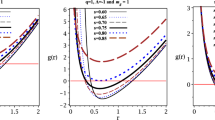Abstract
We discuss the black hole effective action and define its static subsector. We determine the induced gravito-static polarization constants (electric Love numbers) of static black holes (Schwarzschild) in an arbitrary dimension, namely the induced mass multipole as a result of an external gravitational field. We demonstrate that in 4d these constants vanish thereby settling a disagreement in the literature. Yet in higher dimensions these constants are non-vanishing, thereby disproving (at least in d > 4) speculations that black holes have no effective couplings beyond the point particle action. In particular, when l/(d−3) is half integral these constants demonstrate a (classical) renormalization flow consistent with the divergences of the effective field theory. In some other cases the constants are negative indicating a novel non-spherical instability. The theory of hypergeometric functions plays a central role.
Similar content being viewed by others
References
The Oxford English dictionary, www.oed.com, retrieved on 12 September 2011.
A.E.H. Love, Some problems of geodynamics, Cambridge University Press, Cambridge U.K. (1911) [Dover, New York U.S.A. (1967)], see also http://en.wikipedia.org/wiki/Augustus_Edward_Hough_Love.
Y.-Z. Chu, W.D. Goldberger and I.Z. Rothstein, Asymptotics of d-dimensional Kaluza-Klein black holes: beyond the Newtonian approximation, JHEP 03 (2006) 013 [hep-th/0602016] [INSPIRE].
B. Kol and M. Smolkin, Classical effective field theory and caged black holes, Phys. Rev. D 77 (2008) 064033 [arXiv:0712.2822] [INSPIRE].
J.B. Gilmore, A. Ross and M. Smolkin, Caged black hole thermodynamics: Charge, the extremal limit and finite size effects, JHEP 09 (2009) 104 [arXiv:0908.3490] [INSPIRE].
K. Schwarzschild, On the gravitational field of a mass point according to Einstein’s theory, Sitzungsber. Preuss. Akad. Wiss. Berlin (Math. Phys.) 1916 (1916) 189 [physics/9905030] [INSPIRE].
E.E. Flanagan and T. Hinderer, Constraining neutron star tidal Love numbers with gravitational wave detectors, Phys. Rev. D 77 (2008) 021502 [arXiv:0709.1915] [INSPIRE].
T. Damour and A. Nagar, Relativistic tidal properties of neutron stars, Phys. Rev. D 80 (2009) 084035 [arXiv:0906.0096] [INSPIRE].
T. Binnington and E. Poisson, Relativistic theory of tidal Love numbers, Phys. Rev. D 80 (2009) 084018 [arXiv:0906.1366] [INSPIRE].
T. Damour and O.M. Lecian, On the gravitational polarizability of black holes, Phys. Rev. D 80 (2009) 044017 [arXiv:0906.3003] [INSPIRE].
W.D. Goldberger and I.Z. Rothstein, An effective field theory of gravity for extended objects, Phys. Rev. D 73 (2006) 104029 [hep-th/0409156] [INSPIRE].
W.D. Goldberger, Les Houches lectures on effective field theories and gravitational radiation, hep-ph/0701129 [INSPIRE].
T. Damour and G. Esposito-Farese, Testing gravity to second postNewtonian order: a field theory approach, Phys. Rev. D 53 (1996) 5541 [gr-qc/9506063] [INSPIRE].
V. Asnin, D. Gorbonos, S. Hadar, B. Kol, M. Levi and U. Miyamoto, High and low dimensions in the black hole negative mode, Class. Quant. Grav. 24 (2007) 5527 [arXiv:0706.1555] [INSPIRE].
B. Kol and E. Sorkin, On black-brane instability in an arbitrary dimension, Class. Quant. Grav. 21 (2004) 4793 [gr-qc/0407058] [INSPIRE].
W.D. Goldberger and I.Z. Rothstein, Dissipative effects in the worldline approach to black hole dynamics, Phys. Rev. D 73 (2006) 104030 [hep-th/0511133] [INSPIRE].
B. Kol, The delocalized effective degrees of freedom of a black hole at low frequencies, Gen. Rel. Grav. 40 (2008) 2061 [arXiv:0804.0187] [INSPIRE].
B. Kol and M. Smolkin, Non-relativistic gravitation: from Newton to Einstein and back, Class. Quant. Grav. 25 (2008) 145011 [arXiv:0712.4116] [INSPIRE].
H. Kodama and A. Ishibashi, A master equation for gravitational perturbations of maximally symmetric black holes in higher dimensions, Prog. Theor. Phys. 110 (2003) 701 [hep-th/0305147] [INSPIRE].
A. Ishibashi and H. Kodama, Stability of higher dimensional Schwarzschild black holes, Prog. Theor. Phys. 110 (2003) 901 [hep-th/0305185] [INSPIRE].
R. Beals and R. Wong, Special functions, Cambridge University Press, Cambridge U.K. (2010).
F.J. Zerilli, Effective potential for even parity Regge-Wheeler gravitational perturbation equations, Phys. Rev. Lett. 24 (1970) 737 [INSPIRE].
V. Asnin and B. Kol, Dynamical versus auxiliary fields in gravitational waves around a black hole, Class. Quant. Grav. 24 (2007) 4915 [hep-th/0703283] [INSPIRE].
B. Kol, Perturbations around backgrounds with one non-homogeneous dimension, hep-th/0609001 [INSPIRE].
D. Gorbonos and B. Kol, A dialogue of multipoles: matched asymptotic expansion for caged black holes, JHEP 06 (2004) 053 [hep-th/0406002] [INSPIRE].
I. Vega, E. Poisson and R. Massey, Intrinsic and extrinsic geometries of a tidally deformed black hole, Class. Quant. Grav. 28 (2011) 175006 [arXiv:1106.0510] [INSPIRE].
R. Gregory and R. Laflamme, Black strings and p-branes are unstable, Phys. Rev. Lett. 70 (1993) 2837 [hep-th/9301052] [INSPIRE].
B. Kol and M. Smolkin, Dressing the post-Newtonian two-body problem and classical effective field theory, Phys. Rev. D 80 (2009) 124044 [arXiv:0910.5222] [INSPIRE].
W.D. Goldberger and A. Ross, Gravitational radiative corrections from effective field theory, Phys. Rev. D 81 (2010) 124015 [arXiv:0912.4254] [INSPIRE].
Author information
Authors and Affiliations
Corresponding author
Additional information
ArXiv ePrint: 1110.3764
Rights and permissions
About this article
Cite this article
Kol, B., Smolkin, M. Black hole stereotyping: induced gravito-static polarization. J. High Energ. Phys. 2012, 10 (2012). https://doi.org/10.1007/JHEP02(2012)010
Received:
Revised:
Accepted:
Published:
DOI: https://doi.org/10.1007/JHEP02(2012)010




